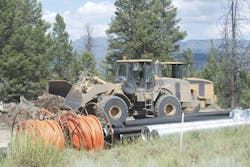The need for more middle mile
By Gary Bolton / Fiber Broadband Association
As America continues to build high-speed last-mile networks to connect every household in the country with reliable, low-latency broadband, one component is needed to enable and unlock the full potential of these networks. There is a well-documented need for more middle mile infrastructure to connect unserved and underserved towns across the country, and to lower the cost of broadband to mid-sized communities that are not as well served as major cities.
In 2024, NTIA’s Enabling Middle Mile Infrastructure Program awarded $980 million in grants to 36 organizations across 40 states and territories to deploy, lease, or upgrade existing networks. From the awards, construction began in eight states to build or upgrade nearly 1,500 miles of much-needed middle mile fiber.
However, there was at least $4.7 billion in grant applications, indicating a substantial oversubscription and a considerable need for more investment in enabling connectivity to unserved areas. Middle mile networks are needed for every type of last-mile high-speed broadband service, including cable, fiber, satellite, 5G cellular, and fixed wireless solutions of both unlicensed and licensed varieties. The combination of low latency and near-infinite capacity of fiber means we’ll continue to need to pull and light up more middle mile in the years to come to support all the different last-mile connectivity being turned on and upgraded.
Enabling higher speeds
Being able to scale to ever-faster speeds will require more middle mile network coverage at affordable prices. While the Federal Communications Commission (FCC) recently raised its definition of broadband to 100 Mbps upstream and 20 Mbps downstream, that benchmark is already outdated for current and future use. Real-world observations show that active households often exceed usage of 100 Mbps and higher, depending on the number of people in the household and the applications involved.
All major carriers and many smaller ones are selling – and people are buying – multi-gigabit broadband service plans ranging from 5 Gbps to 8 Gbps on existing XGS-PON technology, with others already pushing the boundaries to go even faster. GFiber is successfully selling 20 Gbps services in combination with Wi-Fi 7 as a part of its GFiber labs initiative, and we can expect other carriers to follow suit as 25G PON and 50G PON technologies continue to make their way into production.
In addition to providing connectivity with the rest of the world, middle mile networks contribute to robust and resilient communications by offering diverse routing, thereby avoiding single-point disruptions from adverse events that can disrupt service, such as extreme weather or man-made mishaps. Given that fiber is the essential technology for reliable and secure first responder and national security communications, an investment in fiber is an investment in safety that isn’t affected by space weather.
More middle mile infrastructure helps lower the cost of broadband through increased competition. Rather than a single long-distance vendor holding a monopoly on access to mid-sized cities and more distant locations, multiple options create a free marketplace where service providers and local governments can seek the best value.
Today’s middle mile network design and capacity planning have often been based on assumptions from 20 years ago, with high-speed broadband defined as the best speed that could be achieved with a copper wire and cellular voice services that delivered a relatively large 127-character message. Today’s phones consume data just for navigation and playing tunes, while next-generation cellular and fixed-wireless services are pushing existing middle mile bandwidth upgrades to support 5G services on both handsets and in homes.
Supporting emerging applications
More middle mile connectivity is needed to support next-generation applications, such as precision agriculture, and to provide the framework for attracting and retaining new businesses outside of traditional urban areas. Precision agriculture will require high-speed, symmetrical bandwidth and high-speed “last acre” wireless networks for the constant flow of data between the field and cloud services, designed to optimize crop inputs for optimal yields. This approach saves money while reducing water and fertilizer usage.
Autonomous farm vehicles are eliminating the monotony of preparing and tending fields and harvesting crops, allowing farmers to operate and supervise them from the comfort of their homes, rather than spending 8 to 12 hours a day in a hot cab during the summer.
A fleet of autonomous vehicles generates gigabytes of data per day, including onboard video for guidance and safety, as well as telematics that indicate when they need to be fueled and serviced. We need to start installing more middle mile fiber today to enable the farms of tomorrow.
Eying current and future demands
In June at Fiber Connect 2025, the Fiber Broadband Association’s Middle Mile Working Group released its first white paper discussing the need for more middle mile capacity and recommendations for designing more robust middle mile infrastructure designed to meet today’s and tomorrow’s demands. The recommendations are based in part on the committee’s national middle mile survey, which received input from 38 network operators across 25 states on the current condition and future of middle mile networks across America. You can find the paper on FBA’s website at FBA-098_MiddleMileNetworks_WhitePaper_FIN.pdf.
Surprisingly, almost 70% of the ISPs surveyed own and operate their middle mile between their central office and the closest internet exchange (IX), while 30% lease fiber capacity through a transit provider. Most operators of these networks have built them with resiliency in mind, not only implementing redundant fibers but also including diverse geographic routes to the IX.
Current peak traffic on their networks stayed below 100 Gbps for 65% of service providers, but they expect peak traffic will grow substantially over the next five years. Only 22% of providers surveyed believe their traffic will remain below 100 Gbps by 2030, and most expect to scale their middle mile capacity beyond 400 Gbps as demand grows.
Where things get expensive are with backhaul costs for peering and transit. Most providers have backhaul costs that are below 10% of their monthly operating expenses, but 36% reported costs exceeding 10% of their monthly operating expenses. This shouldn’t be a surprise, given that 30% of their capacity is leased through a transit provider.
The high cost of connecting rural locations to the middle mile isn’t something that can be solved with a bargain solution. Anchor institutions, such as schools, hospitals, and libraries, require gigabit and faster speeds to operate effectively, with a minimum of 1 Gbps symmetrical speed, as recognized by the FCC. Community first responders and local governments also need access to affordable high-speed broadband to deliver their vital services.
Considering today’s and tomorrow’s applications, the committee recommends that the planning and construction of middle mile networks be based on peak concurrency per location at 100-200 Mbps for homes as a practical approach to ensure future scalability and cost efficiency. This higher peak takes into consideration the growth of Wi-Fi-enabled devices entering homes, with sources such as Plume IQ and Parks Associates noting that the average household has anywhere from 20 to 25 connected devices.
Adding streaming video, online gaming, remote work, virtual meetings, and the background “hum” of smart home applications running simultaneously results in high concurrency that doesn’t fit into either a bargain last-mile connection or an under-designed middle mile connection.
More middle mile fiber also provides key benefits for the future. Quantum computing will require quantum networks built on fiber, such as those being built at Cisco’s Quantum Labs. Fiber optics sensing using middle mile fiber provides a powerful and unheralded tool for monitoring the world around us, enabling a more accurate assessment of events such as earthquakes and landslides, as well as the ability to discover and unlock geothermal energy resources.
Expect to see more discussions about the middle mile in the month ahead, as improving it will be essential for enabling mid-sized and rural communities to reach their full potential. States will continue to connect the unconnected throughout the country by using BEAD and other programs.
For related articles, visit the Broadband Topic Center.
For more information on high-speed transmission systems and suppliers, visit the Lightwave Buyer’s Guide.
To stay abreast of fiber network deployments, subscribe to Lightwave’s Service Providers and Datacom/Data Center newsletters.

